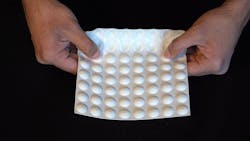Metamaterials Store Energy in Their Skins
Researchers at Purdue University have learned to take advantage of the bistability that occurs in some types of materials to form energy-storing skins. Some materials are bistable and have two separate, stable states; a patterned sheet of bistable material fashioned with certain kinds of mechanical structures can store energy in one state and release it in the other, and can be programmed to store and process data like a simple kind of mechanical computer.
The Purdue researchers have discovered that enough energy can be saved in these bistable materials to perform basic mechanical tasks. According to a Purdue assistant professor of mechanical engineering, Andres Arrieta, “Bistability is an important concept found in nature. Earwigs, for example, have bistable, foldable wings that snap to an open state with very little energy.” As Arrieta observes, the Purdue researchers are planning to learn from nature: “We are working to make programmable structures inspired from this bistability.”
Using convex and concave shapes, Arrieta’s team started experimentation with a simple structure, a pop-up dome. It was three-dimensionally (3D) printed on a 1-in.2 sheet of thermoplastic polyurethane. The dome could become either convex or concave with the press of a finger. Different formats of the domes were printed, with new behaviors becoming apparent from a 3 × 3 grid of the domes (see figure). “When you invert two domes that are close to another, they start interacting,” Arrieta said. “And when you start making patterns of these domes on a sheet, the sheet itself begins to curve globally. Depending on which domes are inverted, you get different shapes.”
Arrieta’s team has investigated larger grids of the metamaterial and has explored the use of the technology in programmable robotic grippers and mechanical batteries. Different shapes can be achieved by actuating the domes in different orders, enabling mechanical computing. “When you think about it, these up-and-down domes are a lot like the 1s and 0s of computer data,” Arrieta said. The work was funded by different agencies, including the U.S. Defense Advanced Research Projects Agency (DARPA) and the U.S. Air Force Office of Scientific Research. A provisional patent for the metamaterial technology has been filed through the Purdue Research Foundation Office of Technology Commercialization.
